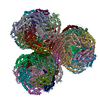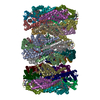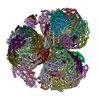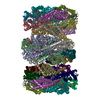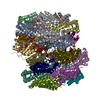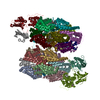+Search query
-Structure paper
| Title | Structures of a phycobilisome in light-harvesting and photoprotected states. |
|---|---|
| Journal, issue, pages | Nature, Vol. 609, Issue 7928, Page 835-845, Year 2022 |
| Publish date | Aug 31, 2022 |
 Authors Authors | María Agustina Domínguez-Martín / Paul V Sauer / Henning Kirst / Markus Sutter / David Bína / Basil J Greber / Eva Nogales / Tomáš Polívka / Cheryl A Kerfeld /    |
| PubMed Abstract | Phycobilisome (PBS) structures are elaborate antennae in cyanobacteria and red algae. These large protein complexes capture incident sunlight and transfer the energy through a network of embedded ...Phycobilisome (PBS) structures are elaborate antennae in cyanobacteria and red algae. These large protein complexes capture incident sunlight and transfer the energy through a network of embedded pigment molecules called bilins to the photosynthetic reaction centres. However, light harvesting must also be balanced against the risks of photodamage. A known mode of photoprotection is mediated by orange carotenoid protein (OCP), which binds to PBS when light intensities are high to mediate photoprotective, non-photochemical quenching. Here we use cryogenic electron microscopy to solve four structures of the 6.2 MDa PBS, with and without OCP bound, from the model cyanobacterium Synechocystis sp. PCC 6803. The structures contain a previously undescribed linker protein that binds to the membrane-facing side of PBS. For the unquenched PBS, the structures also reveal three different conformational states of the antenna, two previously unknown. The conformational states result from positional switching of two of the rods and may constitute a new mode of regulation of light harvesting. Only one of the three PBS conformations can bind to OCP, which suggests that not every PBS is equally susceptible to non-photochemical quenching. In the OCP-PBS complex, quenching is achieved through the binding of four 34 kDa OCPs organized as two dimers. The complex reveals the structure of the active form of OCP, in which an approximately 60 Å displacement of its regulatory carboxy terminal domain occurs. Finally, by combining our structure with spectroscopic properties, we elucidate energy transfer pathways within PBS in both the quenched and light-harvesting states. Collectively, our results provide detailed insights into the biophysical underpinnings of the control of cyanobacterial light harvesting. The data also have implications for bioengineering PBS regulation in natural and artificial light-harvesting systems. |
 External links External links |  Nature / Nature /  PubMed:36045294 PubMed:36045294 |
| Methods | EM (single particle) |
| Resolution | 2.1 - 3.5 Å |
| Structure data | EMDB-25028, PDB-7sc7: EMDB-25029, PDB-7sc8: EMDB-25030, PDB-7sc9: EMDB-25031, PDB-7sca: EMDB-25032, PDB-7scb: EMDB-25033, PDB-7scc:  EMDB-25068: Synechocystis PCC 6803 Phycobilisome in complex with OCP  EMDB-25069: Synechocystis PCC 6803 Phycobilisome in the up-down rod conformation  EMDB-25070: Synechocystis PCC 6803 Phycobilisome in the down-down conformation  EMDB-25071: Synechocystis PCC 6803 Phycobilisome in the up-up rod conformation |
| Chemicals | 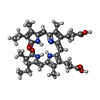 ChemComp-CYC:  ChemComp-HOH:  ChemComp-45D: |
| Source |
|
 Keywords Keywords | PHOTOSYNTHESIS / Complex / light harvesting / pigment |
 Movie
Movie Controller
Controller Structure viewers
Structure viewers About Yorodumi Papers
About Yorodumi Papers




